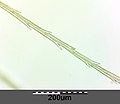Loess dandelion
| Loess dandelion | ||||||||||||
|---|---|---|---|---|---|---|---|---|---|---|---|---|

Loess dandelion ( Taraxacum serotinum ) |
||||||||||||
| Systematics | ||||||||||||
|
||||||||||||
| Scientific name | ||||||||||||
| Taraxacum serotinum | ||||||||||||
| ( Waldst. & Kit. ) Fish. |
The loess dandelion ( Taraxacum serotinum ), also called late dandelion and late blooming dandelion , is a species of the genus dandelion ( Taraxacum ) in the sunflower family (Asteraceae). In the German-speaking area, the species is native to Austria only.
description
Vegetative characteristics
The loess dandelion is a perennial herbaceous plant that usually reaches heights of 5 to 20 centimeters. All leaves form a basal rosette that is pressed against the ground . The tough, almost leathery leaves are quickly narrowed into a mostly short, wide petiole and show a dimorphism : the rosette leaves developed in spring are undivided, elliptical to slightly obovate and finely serrated at the edge. Only the innermost rosette leaves developed at the time of flowering are deeply saw-shaped, as is known from the common common dandelion . Initially, the leaves are gray-tomentose, at least on the underside, later they become bald. The shaft is tubular, leafless, unbranched and, at least upwards, dense white wool.
Generative characteristics
The flowering time of the loess dandelion in Central Europe extends from August to October . The inflorescence is a basket and usually measures 30–40 millimeters in diameter. The basket cover is multi-row. The outer bracts are narrow, linear to eilanzettlich, indistinctly bordered, not completely turned back and much shorter than the inner ones . The basket bottom has no chaff leaves and numerous yellow-orange ray- flowers . A flower has five stamens . The stamens are free but the anthers have grown together to form a tube. The under constant ovary has a pen with two scars on.
The fruiting body of the achenes is smooth or slightly scaly-prickly and, without showing a conical tip section (so-called "pyramid"), drawn together into a hair-like beak that is around once or twice as long as the fruiting body. The pappus is yellowish-white to pale gray and the pappus hairs are feathered.
Chromosome number
The number of chromosomes is 2n = 16.
ecology
The loess dandelion is a hemicryptophyte .
The basket behaves as a pollination-biological unit ( pseudanthium ) and acts like a single flower on the pollinating insects . In contrast to most of the other species from the genus dandelion ( Taraxacum ), the loess dandelion reproduces sexually . The fruits (achenes) are spread by the wind with the help of the parachute-like pappus ( anemochory ).
The loess dandelion is considered to be quite resistant to pasture, which is due to the rosette leaves that are pressed flat against the ground, especially in spring, and are therefore difficult to reach for grazing animals. The disappearance of pastures in recent decades has led to a decline in the loess dandelion population. The species is considered to be a character species of the wood sage-furrow-fescue-dry grass (Astragalo exscapi-Crambetum tatariae = Salvio nemorosae-Festucetum rupicolae).
Systematics
Because of its sexual reproduction, the loess dandelion is easy to distinguish and is part of the Taraxacum sect. Dioszegia (= Taraxacum sect. Serotina ) posed.
distribution
The loess dandelion is native to east- central , south-east and eastern Europe as well as south-west and central Asia . In Austria the loess dandelion reaches its western limit of distribution.
In Austria, the loess dandelion in the Pannonian area rarely occurs on loess walls, dry grass and paths over loess in the colline altitude . The occurrences are limited to the federal states of Vienna , Lower Austria and Burgenland . The species is endangered in Austria.
photos
Individual evidence
- ↑ a b c d e f g h i Manfred A. Fischer, Karl Oswald, Wolfgang Adler: Excursion flora for Austria, Liechtenstein and South Tyrol . 3rd, improved edition. Province of Upper Austria, Biology Center of the Upper Austrian State Museums, Linz 2008, ISBN 978-3-85474-187-9 , p. 963 .
- ↑ a b c d e f Manfred A. Fischer: Relics of the ice age to early ice age loess vegetation , in: Heinz Wiesbauer and Herbert Zettel: Hohlwege und Lössterrassen in Niederösterreich , Vienna 2014, ISBN 3-901542-42-6
- ↑ Taraxacum serotinum at Tropicos.org. In: IPCN Chromosome Reports . Missouri Botanical Garden, St. Louis
- ↑ Entry in The Euro + Med PlantBase - the information resource for Euro-Mediterranean plant diversity, accessed on September 8, 2014







